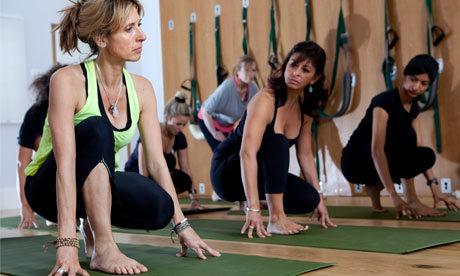
Jane Kersel and Tim Goullet have no truck with Buddha statues or burning incense. You will not hear "namaste" or "Om" in their new London studio. Instead the poses they teach eschew tongue-twisting Sanskrit names and aim for simplicity: a twisting pose is called Road Runner, after the cartoon bird, a pair of lifts are simply "hard" and "harder". Traditional yoga this isn't.
Called Shed (simplify, heal, empower, detox), this exercise method has been developed by Goullet, an osteopath, and Kersel, a yoga teacher. The programme will start in London in September and the inventors' hope is that it will attract those who might not normally venture into a yoga class.
"Yoga's millennia-old series of poses weren't designed for bodies with modern ailments," says Kersel, referring to conditions such as the tight hamstrings and shoulders, and sore backs that can result from days spent in front of a computer. Moreover, she says that the discipline's spiritual origins also don't appeal to everyone. "We want to make it fun, and want the average person to be able to do it. If you ask around any yoga class as to why people are there, 90% say they just want to look good in a bikini."
Jez Cartwright, 39, is Shed's target audience. He goes to the gym three or four times a week to do weights and to run. But the Shed class was his first experience of any yoga-type exercise. "It's always a bit embarrassing for men to do aerobics or yoga," he says. "I've always thought of it as quite hard. But they've taken out all the mumbo-jumbo. I had to concentrate harder than at the gym, which felt like a workout in itself."
It's not the first attempt to demystify yoga. Bikram yoga is also less spiritual than traditional forms. Its 26 postures are designed by its founder, Bikram Choudhury. Classes resemble aerobics sessions: heart rates sky-rocket, teachers wear headsets, and the focus is on the physical. Yet postures retain their Sanskrit names and their roots are clearly in the Hatha yoga tradition. Even so, Choudury has been slammed by traditionalists for making money from an ancient discipline through patenting postures and sexualising yoga.
Other attempts to make yoga more accessible have been met with similar disapproval. New York's Tara Stiles attracts huge audiences with her down-to-earth YouTube videos and iPhone apps of short routines such as "high-heel yoga". Her book Slim Calm Sexy Yoga is packaged like an exercise video and promises rapid weight loss. Critics, however, have labelled it bastardised and sexist.
Yet Stiles's mantra, like Shed's, is that "yoga is for everyone". She says she wants firemen and people in rural areas to take it up and argues that the discipline's status in the west is exclusive and elitist. "I get letters from army and navy guys who do yoga online – people who wouldn't be caught dead in a yoga studio," she explains.
So why does yoga get people so riled? Purists say that it is not just an exercise routine and that for serious students it is a way of life. "People have a daily practice, it's sacred," points out Jennilyn Carson on her website Yogadork.com. "Someone like Tara Stiles who strips it of its spirituality is seen as blasphemous."
Swami Pragyamurti Saraswati, director of the Satyananda Yoga Centre in London, says those who remove its spirituality miss the point. "It saddens me when yoga is restricted to its asanas (poses). It reduces human beings to just bodies and it's not yoga. Yoga is a broad and ancient philosophy, and a focus on its physical side is out of balance with what it stands for." She adds that the mental and spiritual aspects don't put people off, either. "The opposite, actually. We have a huge spectrum of people here, not just skinny girls under 40. People looking for the hot, sweaty stuff usually go elsewhere."
Goullet insists that Shed is not supposed to supplant traditional yoga "Our method works on many levels, physical and spiritual," he says. "It will get your body in good shape for any form of exercise."
But Hamish Hendry, a leading UK teacher of traditional ashtanga yoga, challenges the idea that yoga is not suitable for 21st-century bodies. "Most of my ashtanga students are modern people who sit at desks all day. Yoga certainly works for them," he says.
"I believe the spiritual aspect of yoga is as important as the physical, but for a lot of people, that spiritual level comes later." But, he says, having a choice is no bad thing. "There's so much out there, it's all good. People can find something to suit them."

